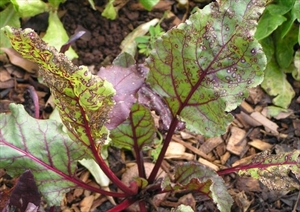Beetroot leaf spot
Pacific Pests, Pathogens and Weeds - Online edition
Pacific Pests, Pathogens & Weeds
Beetroot (silver beet) leaf spot (320)
Cercospora beticola
Asia, Africa, North, South and Central America, the Caribbean, Europe, Oceania. It is recorded from Australia, Cook Islands, New Caledonia, Niue, Papua New Guinea, and Tonga.
Beta species (Beta vulgaris, beetroot, silver beet, and Beta vulgaris variety saccharifera, sugar beet), Amaranthus, spinach, and lettuce. Many weeds are hosts: Chenopdium, Amaranthus, Plantago and Verbena.
Leaf spots, round to irregular, 2-5 mm wide, ash-grey to pale brown, usually with a brown or reddish-purple border often severe on older leaves (Photo 1). Spores develop in the centre of the spots. The centre of the spots fall out, giving a 'shot-hole' symptom. The disease can be severe on older leaves; the spots join together, the leaves dry and later collapse, although remain attached to the plant.
Spread over short distances occur by rain splash whereas, over longer distances, it occurs in wind and seed. Survival occurs on crop remains: spores only last a few months, but the fungal strands of the stromata, last 1-2 years. The fungus also survives on weeds and seeds between crops of beet. Seed infection is common in sugar beet, especially in Europe, the US and India. Warm (20-30°C) wet weather with showers favours the disease.
Severe outbreaks with loss of (sugar) yield are reported in sugar beet from many countries of the world. Several studies have shown that losses occur when disease severity at harvest is more than 10% of the leaf area. Impact of the disease on beetroot is less well reported. In Australia, it is a common disease of beetroot and silver beet, but usually unimportant. However, it is likely to be a problem in crops grown for baby-leaf, especially as the healthy appearance of the leaves if important.
Look for the distinctive circular leaf spots with light centres and wide dark margins. Look for spots where, typically, the centres fall out. Seed health tests are available for this fungus1. Look for the stromata under a low power microscope.
CULTURAL CONTROL
Before planting:
- Make sure that the seed is certified free of the fungus.
During growth:
- Control weeds, especially Chenopodium species (e.g., fat-hen, Chenopodium album).
After harvest:
- Collect and burn or bury as much of the crop as possible after harvest.
- Do not plant one crop of beet after another in the same land; use a rotation of at least 2 years, rotating with non-host vegetables.
RESISTANCE VARIETIES
For sugar beet, tolerant varieties are available, with resistance dependent upon effectiveness of spores to infect, the abundance of sporulation and time between infection and the production of spores.
CHEMICAL CONTROL
Use mancozeb. Apply when symptoms first appear, repeating at 7-10 intervals. During warm, wet weather, favourable to the disease, increase the concentration of the spray and use the shorter interval.
____________________
When using a pesticide, always wear protective clothing and follow the instructions on the product label, such as dosage, timing of application, and pre-harvest interval. Recommendations will vary with the crop and system of cultivation. Expert advice on the most appropriate pesticides to use should always be sought from local agricultural authorities.
AUTHORS Grahame Jackson & Eric McKenzie
Information Diseases of vegetable crops in Australia (2010). Editors, Denis Persley, et al. CSIRO Publishing; and CABI (2017) Cercospora beticola (cercospora leaf spot of beets). Crop Protection Compendium. (https://www.cabi.org/cpc/datasheet/12191); and from (including Photo 1) McKenzie E (2013) Cercospora beticola: PaDIL - (http://www.padil.gov.au).
Produced with support from the Australian Centre for International Agricultural Research under project PC/2010/090: Strengthening integrated crop management research in the Pacific Islands in support of sustainable intensification of high-value crop production, implemented by the University of Queensland and the Secretariat of the Pacific Community.




